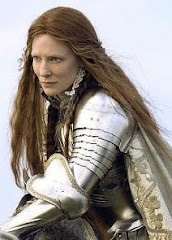Hokey Dokey. Here's the article as I sent it to Zette.
It will be interesting to see if it undergoes any form of editing between now and publication.
---
He cut sharply across the path and trampled on the blades of grass.
Coming to literature from an artistic background, I discovered all manner of wonderful and practical parallels, the most powerful of which is the word palette, or theme set. An artist defines a palette of colours designed to create a particular mood; to elicit and enhance an emotional state. She might consider warm and cool colours, earth colours, colour harmony, colour context, or even colour symbolism.
For the author, this is one of the greatest of skills: to shepherd the reader across a carefully controlled, undulating emotional topography; to guide the reader from one emotional state to the next.
On our shared blog, my young son explained how he created one of his drawings:
'About the coulers I tri to youes evry colur ones.' (About the colours, I try to use every colour once.)
What we find with experience, however, is, as T.S. Eliot contended:
'When forced to work within a strict framework the imagination is taxed to its utmost - and will produce its richest ideas. Given total freedom the work is likely to sprawl.'
We can use words as the artist uses colours, or as the composer uses keys and ideé fixes. If, for example, our protagonist is walking into peril, we can mix threat upon our palette. Tower blocks might skewer the sky, and cyclists carve through the traffic.
In each word, we find an opportunity to heighten the reader's emotional state.
Similes and metaphors provide ideal opportunities for tapping into those private domains of the reader's mind. Maybe the rain fell like an angel's love; maybe it fell like poison-tipped daggers. And, should we forsake descriptions in order to, say, raise the pace, we can focus our attention on our verbs and nouns (and even assign a fresh and valuable intent to adverbs), and our protagonist CUT SHARPLY across the path and trampled on the BLADES of grass.
Brains like patterns and repetition. They pick them out and endeavour to make sense of them, even if they do not tell us that they are doing so.
Hemingway (influenced by Stein) was most fond of repeating key words, raising motifs to the fore, ensuring that what was important would be inescapable, guiding the reader with a parental hand.
In using word palettes, not only can we heighten and crystallize an emotional state through this form of subliminal impressioning, we can create anticipation too: we can encourage the reader to understand something without realizing how he has attained this understanding (not unlike a phantom pov in which an eerie and mysterious knowledge is imparted). Indeed, most authors (if not all) already consciously use non-verbal communication as a means of forging an understanding (through a 'show'): Adam smiled; Brenda dressed like Cassandra; Dennis took a step back; Ellie clapped her hands together; Flora stood close to Graham.
(I'll bet your brain deciphered my cunning alphabetical code there!)
One of the most beneficial side-effects of this technique is that it encourages us to, as Eliot attests, create more inventive prose, exploring unusual avenues and seeing our scene from a different angle. A chapter that, for some unfathomable reason, fails to hit the mark can be transformed:
* Choose the palette (describe the limitations, typically based on the desired location on the emotional topography).
* Create a themed list of related words.
* Swap in those words where the narrative is receptive.
The surface meaning remains unchanged and is suffused with an invisible duality. Double the power.
When the narrative begins to flow on two levels, it is not uncommon to hear the reader exclaim:
'It made me feel [insert emotion here], and I don't know why!' Indeed, it is not the reader's job to know why. It is ours.
He cut sharply across the path and tiptoed about the blades of grass.
I suspect that there is much room for experimentation with word palettes. I have noticed that Zadie Smith uses tiny, contained pockets of such theme sets; Vladimir Nabokov was rather more liberal with his. Smith’s are playful; Nabokov’s are disturbing.
What would happen if, for example, we painted a scene of hatred with a palette of love? Or if we infused a barren, nihilistic scene, superficially devoid of meaning, with many meaningful theme sets?
The thought of such permutations and opportunities for juxtaposition and concealed markers and cross-pollination are very exciting! To what extent might we translate colour theory to literature?

















